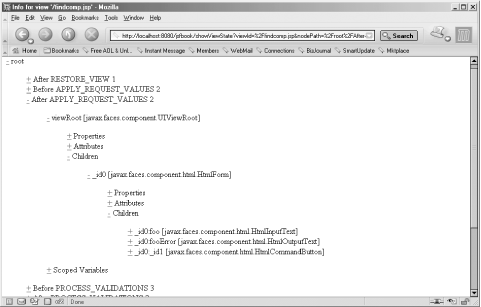Capturing State with a PhaseListener
An interesting use of the PhaseListener class
we discussed in the previous
section is to capture data about the request and all components in
each phase and save the data where it can be picked up and displayed
later. The captured data can be used to better understand what
happens in the different phases and to figure out why things
don’t work as expected.
I developed a PhaseListener that captures most
data of interest, including the component tree structure, all
component attributes and properties, and all variables in the
request, session and application scopes, before and after each phase.
Figure 12-8 shows an example of a response rendered
by a servlet where you can analyze the captured data.
 |
The data is displayed as a tree. The first level of the tree has one
node for each point in the lifecycle. For each such node,
there’s a node that holds the component tree and
another that holds the scoped variables. You can compare a
component’s property values in different phases and
see when they change. For instance, if you look at an input
component, you see how the submitted value migrates from the
submittedValue property to the
localValue and value
properties.
I’ve commented out the registration elements for this listener in the example application’s faces-config.file because there’s a fair amount of processing ...
Get JavaServer Faces now with the O’Reilly learning platform.
O’Reilly members experience books, live events, courses curated by job role, and more from O’Reilly and nearly 200 top publishers.

